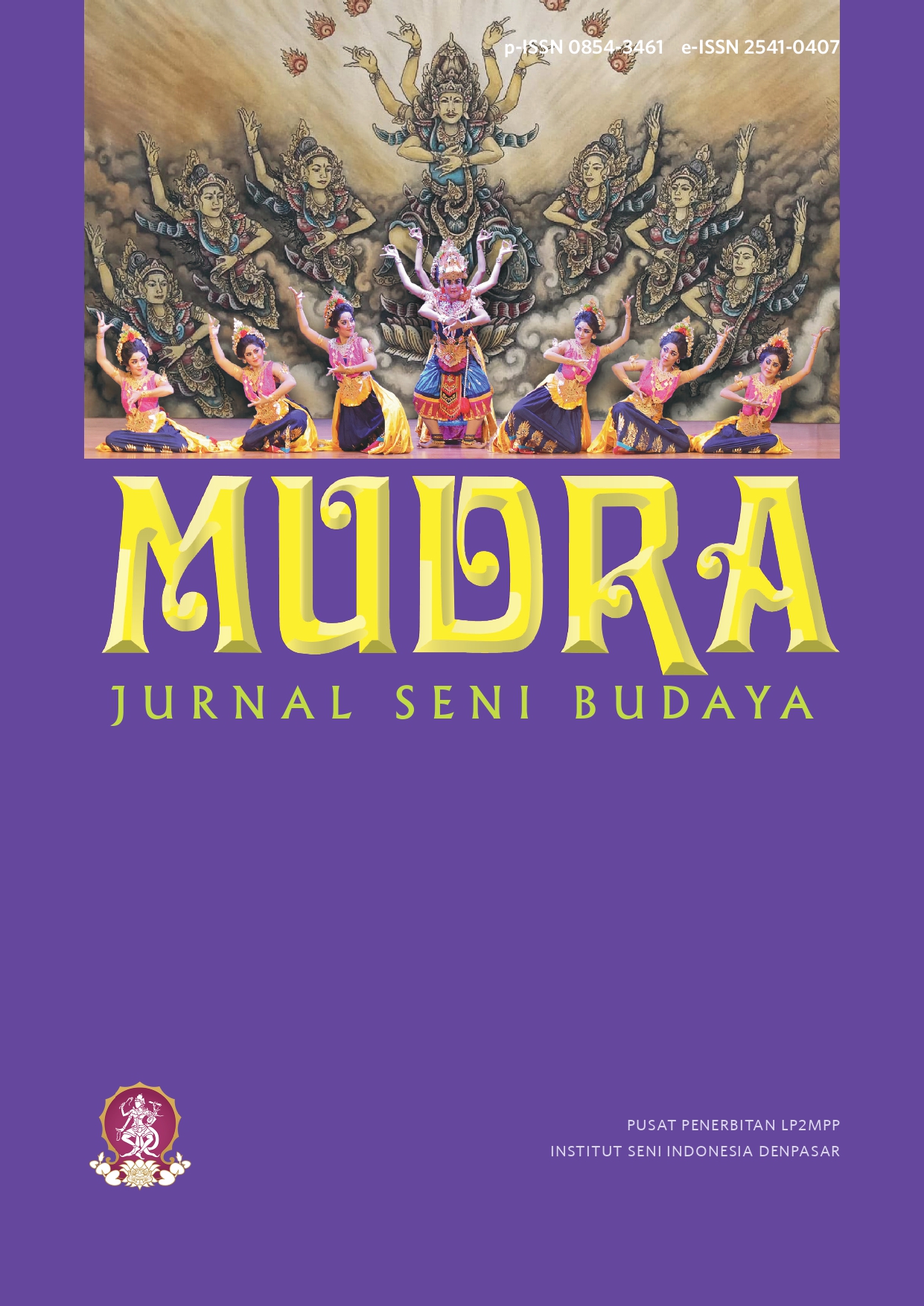The Aesthetic Characteristics of Contemporary Art in Semarang Gallery, Sangkring Art Space and Kiniko Art Based on Practical Economic and Pure Aesthetic Values
DOI:
https://doi.org/10.31091/mudra.v40i2.2970Keywords:
Contemporary Art, Gallery, Aesthetic Value, Economic Value, MarketAbstract
The gallery will select various forms of contemporary artworks based on a range of aesthetic criteria preferences ranging from concept, form, subject matter, relevance to social issues, symbolism, shocking materials, personal feelings, craftsmanship, innovation, current popularity, and others. The selection process for each exhibition dynamically considers these criteria, allowing the gallery to cater to market demands and introduce new aesthetic perspectives to advance Indonesian art. Therefore, this study aims to identify the parameters of aesthetic values used in collecting and exhibiting contemporary art in various galleries in Semarang and Yogyakarta, Indonesia. A descriptive qualitative method with a case study design explored art criticism, formalism, and deconstructivism. The sample population comprised contemporary art created by professional and emerging artists, which was exhibited between 2012 and 2022. Data were obtained from art samples, artists, appreciators, gallery owners, curators, and critics. Owners and curators were required to complete the questionnaire, followed by interviews, documentation, and observation. Conclusions were then drawn by examining the conceptual relationships in each choice of aesthetic value parameters selected by the gallery to identify aesthetic characteristics. The results showed preferences for contemporary reality, uniqueness attached to complex and complicated form processing, technical skills, and exploration of local idioms. Semarang Gallery presented art with unique dimensions beyond mainstream aesthetics. Intellectual ideas can be seen in Andy Dewantoro's 'Isolation', a work demonstrating a metalinguistic concept. The convention of landscape painting, typically characterized by vibrant colours, is challenged and interrogated through scenes rendered solely in black, white, and grey. The artistic mode of art at Semarang Gallery was also more innovative than that of Sangkring Art Space and Kiniko Art, which had several repetitions. Meanwhile, Sangkring Art Space and Kiniko Art focused more on the beauty of visualization than the criticality of visualization. The visual aesthetic in Nurhidayat's "Erotique, Toxique, Exotique" and Anton Afganial's "Uncertainty" present a visual aesthetic that emphasizes poetic functions. These paintings are complex, unified, and intense.Downloads
References
S. Sabana, “Nilai Spritualitas dalam Seni Rupa Kontemporer di Asia Tenggara,” Institut Teknologi Bandung, 2011.
A. I. Saidi, Narasi Simbolik Seni Rupa Kontemporer Indonesia. Jakarta: Isac Book, 2008.
M. S. Lindauer and D. A. Long, “The criteria used to judge art: marketplace and academic comparisons,” Empir. Stud. Arts, vol. 4, no. 2, pp. 163–174, 1986, doi: 10.2190/C9MW-G2XR-MG4V-WKAU. DOI: https://doi.org/10.2190/C9MW-G2XR-MG4V-WKAU
T. Pateman, Key Concepts: A Guide to Aesthetics, Criticism and the Arts in Education. London: Routledge, 1991.
M. M. Eaton, Persoalan-Persoalan Dasar Estetika. Jakarta: Salemba Humanika, 2010.
A. Hills, “Aesthetic testimony, understanding and virtue,” Nous, vol. 56, no. 1, pp. 21–39, 2022, doi: 10.1111/nous.12344. DOI: https://doi.org/10.1111/nous.12344
M. Susanto, Mengapa sih Lukisan Mahal? Wacana Penetapan Harga Karya Seni. Yogyakarta: Dicti Art Laboratory, 2021.
S. Wisetrotomo, Kuasa Rupa, Kuasa Negara: Kurator di Antara Tegangan Pasar dan Kekuasaan, 1st ed. Yogyakarta: Penerbit Buku Baik, 2021.
S. Irvin and J. Dodd, “In advance of the broken theory: philosophy and contemporary art,” J. Aesthet. Art Crit., vol. 75, no. 4, 2017. DOI: https://doi.org/10.1111/jaac.12412
T. Binkley, “Piece: contra aesthetics,” J. Aesthet. Art Crit., vol. 35, no. 3, p. 265, 1977, doi: 10.2307/430287. DOI: https://doi.org/10.2307/430287
Y. Wasano and H. Onishi, “Categorization of contemporary art collectors in Japan: clustering by art purchase motivations and psychographic characteristics,” Cogent Soc. Sci., vol. 10, no. 1, p., 2024, doi: 10.1080/23311886.2024.2382284. DOI: https://doi.org/10.1080/23311886.2024.2382284
Y. A. Piliang, Hipersemiotika: Tafsir Cultural Studies Atas Matinya Makna. Yogyakarta: Jalasutra, 2013.
J. Stallabrass, Contemporary art: a very short introduction. New York: Oxford University Press, 2004.
M. Krampen, “Jakobson’s Model of Linguistic Functions and Modern Painting,” Empir. Stud. Arts, vol. 14, no. 1, pp. 49–63, 1996, doi: 10.2190/C68F-KB07-WN5Y-GD12. DOI: https://doi.org/10.2190/C68F-KB07-WN5Y-GD12
P. Krystina and R. Stephen, Roman Jakobson, Language in Literature. London, 1987.
A. Goldman, “Beardsley’s Legacy: The Theory of Aesthetic Value: Symposium: Monroe Beardsley’s Legacy in Aesthetics,” J. Aesthet. Art Crit., vol. 63, no. 2, pp. 185–189, 2005, doi: https://doi.org/10.1111/j.0021-8529.2005.00196.x. DOI: https://doi.org/10.1111/j.0021-8529.2005.00196.x
R. K. Yin, Studi Kasus: Desain dan Metode. Jakarta: Rajawali Press, 2014.
Widagdo, “Penelitian bidang seni rupa,” in Jaringan Makna Tradisi Hingga Kontemporer, Yogyakarta: Badan Penerbit Institut Seni Indonesia Yogyakarta, 2006.
S. Sunardi, Semiotika negativa. Yogyakarta: Penerbit Buku Baik, 2004.
L. Gross, “Art as the communication of competence,” Soc. Sci. Inf., vol. 12, no. 5, pp. 115–141, 1973, doi: 10.1177/053901847301200504. DOI: https://doi.org/10.1177/053901847301200504
V. Horne, “Kate Davis: Re-Visioning Art History After Modernism and Postmodernism,” Fem. Rev., vol. 110, no. 1, pp. 34–54, 2015, doi: 10.1057/fr.2015.12. 2015. DOI: https://doi.org/10.1057/fr.2015.12
G. Gumilar, “Katalog Formless: on Human Artifice and Natural Order.” .
A. S. Winston, "Simple Pleasures : the Psychological Aesthetics of High and Popular Art," Empir. Stud. Arts, vol. 13, no. 2, pp. 193-203, 1995, doi: 10.2190/U40C-QXB0-4RXQ-8PQ0. DOI: https://doi.org/10.2190/U40C-QXB0-4RXQ-8PQ0
L. S. Adams, The Methodologies of Art an Introduction. New York: Harper Collins Publishers., 1996.
A. D. Lestary, W. Warni, and S. Wulandari, “Kode-Kode Narasi Semiotika Roland Barthes dalam Novel dari Jendela SMP Karya Mira Widjaja,” Kaji. Linguist. dan Sastra, vol. 1, no. 1, pp. 1–8, 2022, doi: 10.22437/kalistra.v1i1.18421. DOI: https://doi.org/10.22437/kalistra.v1i1.18421
M. Meskimmon, Women making art: history, subjectivity, aesthetics. New York: Routledge, 2003.
D. Atkinson, “Contemporary Art and Art in Education: The New, Emancipation and Truth,” Int. J. Art Des. Educ., vol. 31, no. 1, pp. 5–18, 2012, doi: 10.1111/j.1476-8070.2012.01724.x. DOI: https://doi.org/10.1111/j.1476-8070.2012.01724.x
S. LeWitt, “Paragraphs on conceptual art,” Artforum, vol. 5, no. 10, pp. 79–83, 1967.
J. Levinson, “Defining art historically,” Br. J. Aesthet., vol. 19, no. 3, pp. 232–250, 1979, doi: 10.1093/bjaesthetics/19.3.232. DOI: https://doi.org/10.1093/bjaesthetics/19.3.232
E. B. Feldman, Art as Image and Idea, New Yersey. Prentice Hall, 1967.
Downloads
Published
How to Cite
Issue
Section
License
Copyright (c) 2025 Mujiyono Mujiyono, Eko Haryanto

This work is licensed under a Creative Commons Attribution-NonCommercial-ShareAlike 4.0 International License.
- Copyright on any open access article in a journal published by Mudra Jurnal Seni Budaya is retained by the author(s).
-
The Creative Commons Attribution License 4.0 formalizes these and other terms and conditions of publishing articles.









